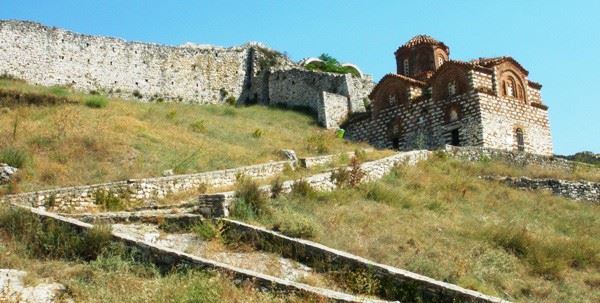When I first saw Albania, it was from the beach at Kassiopi in Corfu. Back in 1990 that 2-mile stretch of the Adriatic Sea separated far more than a mundane international border. I was looking across to what was then Europe’s most secretive and poorest nation. At the time I was fascinated and when I came home I looked into ways of visiting Albania; but as is so often the case, other things (and other places) got in the way, and in the meantime Albania thankfully shook off its chains and emerged as a fledgling democracy. I finally made a visit to Albania in 2010, 20 years later than planned, and in a few short days I saw and experienced enough to make me glad that I hadn’t given up on my plans to visit one of Europe’s most surprising countries.
The most bizarre legacy of the dictator Enver Hoxha’s rule is the profusion of bunkers which litter the countryside. There are an estimated 750,000 of these concrete mushrooms, built by a paranoid man who expected an attack on his country by enemy forces. The bunkers have proved too difficult and costly to remove in any great numbers, and instead many have taken on alternative uses: some have been used as canvases by local artists, while others have become quirky cafes and even hostels.
But Albania’s great attractions belong to an era long before the Cold War years. Saranda, a fairly ordinary town which is now connected to Corfu by a regular hydrofoil service, is a popular place to choose as a base from which to explore southern Albania. It has pebbled beaches, pedestrian-friendly streets and great views across to Corfu, along with a decent selection of seafood restaurants. We found eating out in Albania as a whole to be very light on the pocket (ice-creams in particular were of Italian quality and ridiculously cheap), although variety was hard to come by once we’d had our fill of pizza and pasta.
Around 20 minutes’ drive from Saranda is Butrint, a UNESCO World Heritage Site and one of Albania’s major cultural attractions. It’s known for its extensive Roman ruins, but the ancient city’s rich history includes its formation under the rule of Ancient Greece, along with subsequent heydays as part of the Byzantine Empire and as a Venetian city. Today it’s an impressive archaeological site, and a guide is advisable for those who want to interpret the meaning of the many piles of rocks on the site.
Another UNESCO site can be found at Gjirokastra, one of the best-preserved Ottoman towns in the Mediterranean. It’s a lovely place in which to wander around the steep streets, with shops and a bazaar lending to the Turkish feel. High on the hill over the town is the imposing fortress. The highlight here should be its 12th-century origins, but for most visitors it is inevitably an American spy plane which was shot down during the Cold War.
For those wanting to relax, Ksamili Beach just south of Saranda is a popular spot with visitors and locals, with many small bays and islands just off the shore.
Albania offers an easy opportunity for a twin-centre holiday with Corfu or Sivota on the Greek mainland, providing a contrasting trip and an insight into what remains one of Europe’s least-visited countries.



